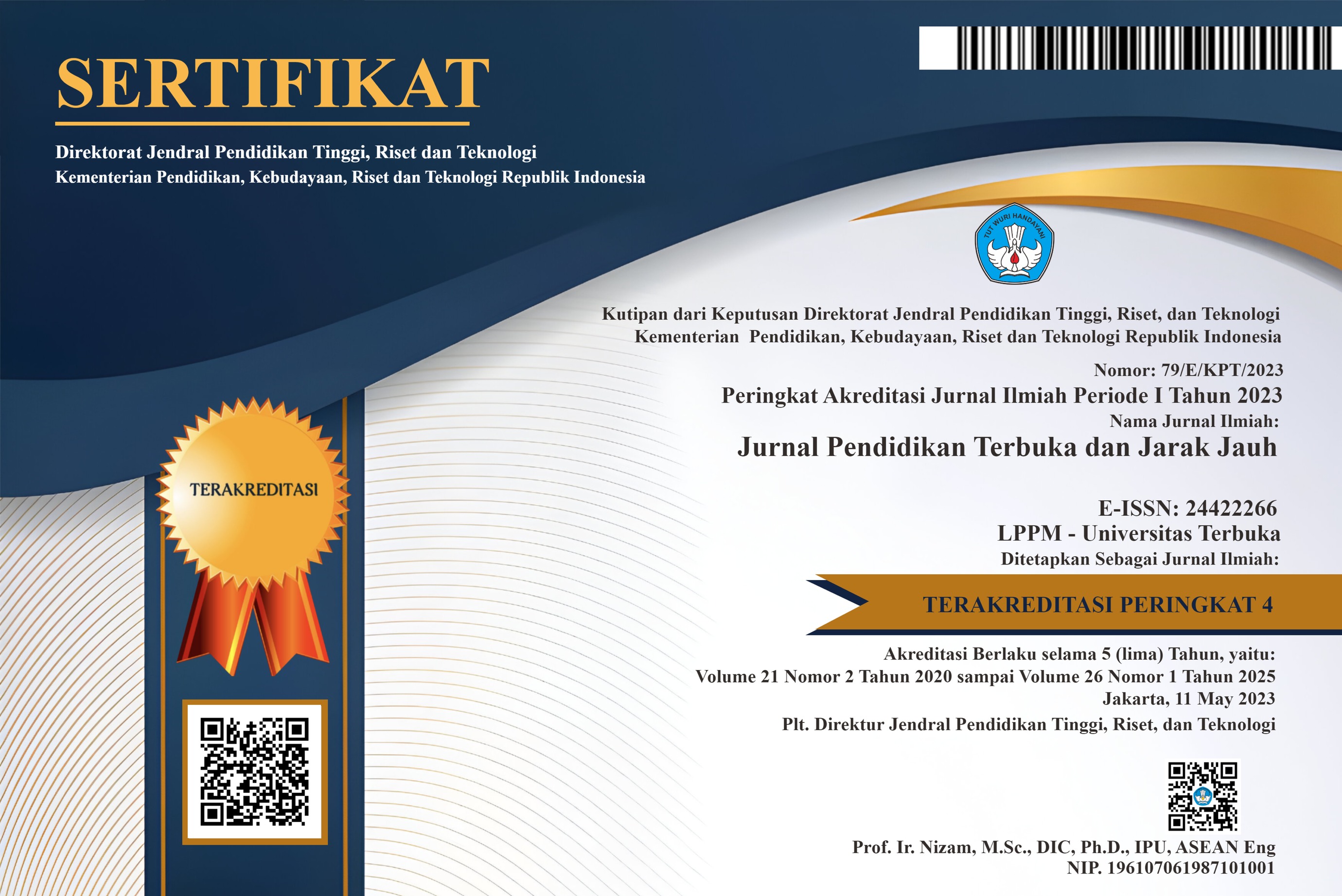Pengembangan Rancangan Pembelajaran Massive Open and Online Courses (MOOCs) Public Speaking
DOI:
https://doi.org/10.33830/ptjj.v24i1.3987.2023Keywords:
Moocs, Public Speaking, Pembelajaran Jarak Jauh (PJJ)Abstract
Artikel ini menjelaskan hasil penelitian tentang pengembangan rancangan pembelajaran dalam Massive Open and Online Courses (MOOCs) Public Speaking. Penelitian ini dilatarbelakangi oleh hasil evaluasi yang menunjukan bahwa MOOCs Public Speaking dinilai belum optimal dari sisi rancangan pembelajaran program, materi pembelajarannya, hingga tes kompetensi. Hasil penelitian digunakan untuk menyempurnakan program MOOCs Public Speaking yang telah dikembangkan oleh Universitas Terbuka agar memenuhi aspek keabsahan dan kelayakan. Metode penelitian yang digunakan adalah kualitatif dengan teknik pengumpulan data melalui wawancara mendalam dengan pakar public speaking, praktisi public speaking, pakar desain instruksional dan dosen UT pengembang MOOCs. Temuan studi menunjukan bahwa secara ideal, pembelajaran Public Speaking secara jarak jauh tetap membutuhkan praktik secara syncrounus dengan jumlah peserta di satu kelas tidak lebih dari 15 untuk mencapai efektivitas program pembelajaran. Apabila diterapkan pada program MOOCs yang sifatnya masif dan self paced, maka dianggap sulit untuk mengakomodasi kebutuhan pembelajaran MOOCs Public Speaking yang ideal.
This research aims to develop learning designs in Massive Open and Online Courses (MOOCs) of Public Speaking. This research is compiled based on the previous research results, which show that MOOCs Public Speaking is not yet optimal regarding program learning design, learning materials, and competency evaluation. The results of this study will benefit improving the MOOCs Public Speaking program developed by Universitas Terbuka (UT) to meet the feasibility aspect. This research used the research and development method to design a syllabus or learning strategy for the MOOCs Public Speaking program. Data collection techniques were conducted through in-depth interviews with informants, including public speaking experts, public speaking practitioners, instructional design experts and UT lecturers who developed MOOCs. The study findings show that, ideally, distance learning Public Speaking course still requires synchronous mode with no more than 15 participants in one class to achieve the learning program's effectiveness. On the other side, when applied to the massive and self-paced MOOCs program, it is considered challenging to accommodate the ideal learning needs of MOOCs Public Speaking.
References
Belawati, T. (2020). Pembelajaran Online. Universitas Terbuka.
Bruff, D. O., Fisher, D. H., Mcewen, K. E., & Smith, B. E. (2013). Wrapping a MOOC: Student Perceptions of an Experiment in Blended Learning. In MERLOT Journal of Online Learning and Teaching (Vol. 9, Issue 2).
Chua, J. S. M., & Lateef, F. A. (2014). The Flipped Classroom: Viewpoints in Asian Universities. Education in Medicine Journal, 6(4). https://doi.org/10.5959/eimj.v6i4.316
Daniel, J. (2012). Making Sense of MOOCs: Musings in a Maze of Myth, Paradox and Possibility.
Fiani, I. D., Windrati, N. K., Arisanty, M., & Dewi, D. K. (2021). Tipologi Gaya Video Instruksional di Universitas Terbuka TV. IKOMIK: Jurnal Ilmu Komunikasi Dan Informasi, 1(1), 40–47. https://doi.org/10.33830/ikomik.v1i1.1879
Grünewald, F., Meinel, C., Totschnig, M., & Willems, C. (2013). Designing MOOCs for the Support of Multiple Learning Styles (pp. 371–382). https://doi.org/10.1007/978-3-642-40814-4_29
Li, Z., & Zhou, X. (2021). Flipping a Virtual EFL Public Speaking Class Integrated With MOOCs During the COVID-19 Pandemic. International Journal of TESOL Studies. https://doi.org/10.46451/ijts.2021.03.05
Nila Kusuma Windrati, Isma Dwi Fiani, & Arifah Bintarti. (2021). Partisipasi Mahasiswa Program Studi S1 Ilmu Komunikasi Fhisip UT pada Program MOOCS Public Speaking yang Dikembangkan UT. Jurnal Pendidikan Terbuka Dan Jarak Jauh, 22(1), 10–18. https://doi.org/10.33830/ptjj.v22i2.2302.2021
Sergio Luján Mora. (2013). MOOC (Massive Open Online Courses). http://desarrolloweb.dlsi.ua.es/moocs/what-is-a-mooc
Yousef, A. M. F., Chatti, M. A., Schroeder, U., Wosnitza, M., & Jakobs, H. (2014). MOOCs - A Review of the State-of-the-Art. Proceedings of the 6th International Conference on Computer Supported Education, 9–20. https://doi.org/10.5220/0004791400090020
Yousef, A., Yousef, F., Schroeder, U., & Wosnitza, M. (2015). An Evaluation of Learning Analytics in a Blended MOOC Environment Responsibility in Educational Contexts View project Duale Berufsausbildung in Äthiopien View project. https://www.researchgate.net/publication/279203093
Downloads
Published
How to Cite
Issue
Section
License
Copyright (c) 2023 Nila Kusuma Windrati, Isma Dwi Fiani, Arifah Bintarti

This work is licensed under a Creative Commons Attribution-ShareAlike 4.0 International License.





